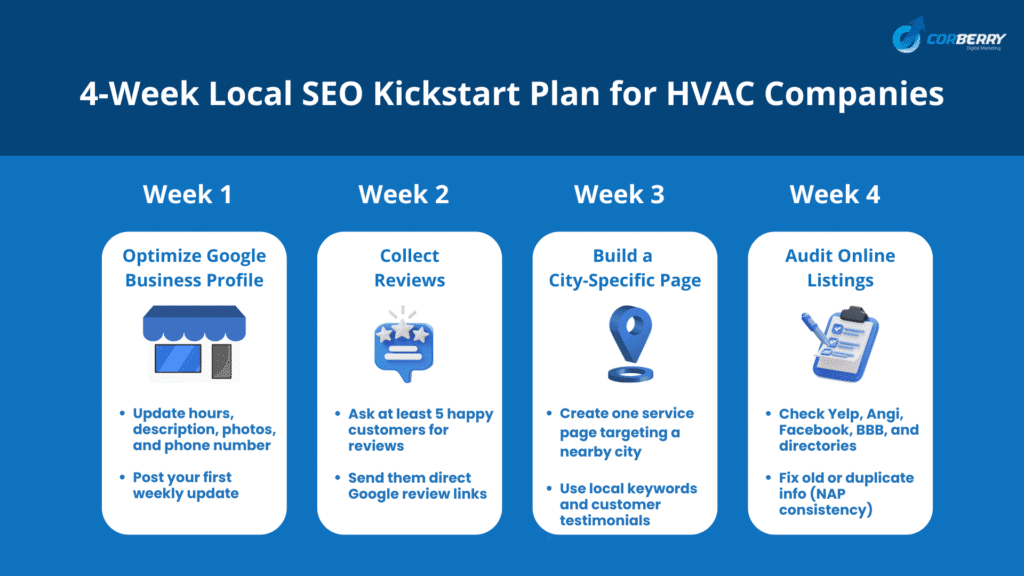Running an HVAC company isn’t just about fixing furnaces or installing air conditioners; it’s about being found the moment homeowners need you. Today’s customers don’t shop around when their AC fails in a heatwave. They grab their phone, type “AC repair near me,” and call the first trustworthy option.
That’s why Local SEO for HVAC is very critical. Unlike paid ads that disappear when your budget runs out, SEO establishes long-term visibility and credibility, generating a steady stream of leads.
Here are seven expert-backed, actionable steps that will help you dominate local search in 2025.
Key Takeaways: Local SEO for HVAC in 2025
If you want your HVAC business to appear first when homeowners search for “AC repair near me” or “furnace installation [city],” you need a focused local SEO strategy. Here’s what this blog covers:
- Google Business Profile optimization — make it your top lead generator.
- Keyword strategy for HVAC services — align content with how customers actually search.
- Consistency across online listings — fix NAP errors (Name, Address, Phone).
- Customer reviews — build trust and improve Google rankings.
- Local Services Ads (LSAs) — use them alongside SEO for maximum visibility.
- City-specific service pages — create dedicated content for each service area.
- Tracking performance — monitor calls, leads, reviews, and traffic to refine results.
By applying these seven tactics, HVAC companies can improve their rankings, generate more local leads, and stay ahead of competitors in 2025.
1. Make Your Google Business Profile Your Best Salesperson
Your Google Business Profile (GBP) is more than a listing; it’s the first impression customers get of your business on Google Maps and search results. For many homeowners, it’s the first interaction they’ll have with your HVAC company.
And when someone’s AC breaks down in the middle of a heatwave, or their furnace quits on a freezing night, they’re not looking to compare a dozen options. They want fast answers and proof they can trust you. That’s where a well-optimized GBP does the heavy lifting.
How to make your profile stand out:
- Stick to your real business name. Don’t pad it with keywords like “Cheap AC Repair – Dallas HVAC Services.” Google flags it, and customers see right through it.
- Keep your hours accurate. Emergencies don’t follow a 9-to-5 schedule. If you’re open 24/7, say it. If not, ensure your hours accurately reflect reality and update them to reflect holidays.
- Use a local phone number. A community-based number builds confidence. A generic call center line feels cold and distant.
- Write a clear description. Focus on what you do and who you serve. Example: “Family-owned HVAC company serving Dallas for 20 years. Specializing in AC repair, furnace replacement, and 24/7 emergency service.”
- Add authentic photos. Share moments of your crew working and the results of your service. Authentic images connect more strongly than polished stock photos.
- Post updates regularly. Keep your profile active and show customers you’re responsive by posting updates regularly, for example, a weekly post like ‘Now scheduling fall furnace tune-ups, call today!’
Treat your GBP like a mini-website. Many customers will never even visit your site if they can get the information they need right there on your profile.
2. Use the Same Language Your Customers Speak
Most homeowners don’t search for “HVAC contractor.” They type exactly what they need: “AC repair near me,” “furnace replacement Plano TX,” or “emergency heating service 24/7.” This is why keyword research is non-negotiable. You need to align your content with customer intent.
Practical keyword strategies for HVAC companies:
| Keyword Type | Examples |
| Location-based terms | AC repair [city]Furnace installation [city]Emergency HVAC service [city] |
| Service-based terms | Ductless mini-split installationHeat pump repairIndoor air quality testing |
| Urgency-driven terms | 24-hour AC repair near meSame-day furnace repair |
How to apply this:
- Incorporate these naturally throughout your website pages (service pages, blog posts, FAQs).
- Add them to your GBP services list.
- Use them in headlines, “AC Repair in Arlington: Fast, Reliable Service When You Need It Most.”
Remember: Write like a human, not a robot. If your content reads like it’s stuffed with keywords, customers and Google will bounce.
3. Keep Your Business Info Consistent Across the Web
Inconsistencies in your NAP (Name, Address, and Phone number) are a silent SEO killer. If your Yelp profile has an old phone number, your Facebook page lists a different address, and your Angi profile is missing a ZIP code, Google gets mixed signals about your business.
And when Google is unsure, it pushes you lower in rankings.
Steps to clean up your online presence:
- Audit your listings on Yelp, Angi, BBB, HomeAdvisor, Facebook, and local directories.
- Correct outdated or duplicate entries.
- Use identical formats; even minor differences, such as “St.” vs. “Street,” can create confusion.
- Consider using a tool like Yext, BrightLocal, or Moz Local to monitor and manage listings.
Think of NAP consistency as the foundation of trust between your business and search engines. If you wouldn’t hand out business cards with three different phone numbers, don’t let the internet do it either.
4. Turn Your Happy Customers Review Champions
In local SEO, reviews are gold. They influence rankings in Google’s “Map Pack” and instantly build credibility with new customers. With 98% of people checking reviews before hiring a local service, your reputation is often decided before you ever get a call. In the HVAC industry, where trust is everything, reviews can make or break you.
How to build a steady stream of reviews:
- Ask immediately after completing a job. Timing is everything.
- Send a simple follow-up text or email with a direct Google review link.
- Train your team to ask politely in person: “If you’re happy with today’s service, would you mind leaving us a quick Google review? It really helps small businesses like ours.”
- Respond to every review. Thank the happy ones. Address the unhappy ones calmly and professionally.
Example: If a customer complains about cost, reply with: “Thank you for your feedback. We understand pricing is important, and we always work to provide genuine, competitive quotes. We’d be happy to discuss this further and see how we can help.”
A few negative reviews won’t sink you, but silence will. Customers often trust a business with 4.7 stars and 200 reviews more than one with a perfect 5.0 rating and only five reviews.
5. Double Your Visibility with Local Services Ads
Local SEO builds long-term momentum. However, if you want results immediately, Google’s Local Services Ads (LSAs) make it easy for your business to stand out. They appear at the top of search results with a green “Google Guaranteed” badge, which immediately builds trust.
Why LSAs are tailor-made for HVAC businesses:
- You only pay per lead (not per click).
- Ads appear above both regular ads and organic results.
- Customers see you’re “Google Guaranteed,” which includes background checks and verification.
- Leads are often higher quality because customers are actively searching for your service in your area.
LSAs aren’t a replacement for SEO. Use LSAs to capture urgent demand and SEO to build a lasting presence. Together, they create a balanced approach to lead generation.
6. Create City-Specific Service Pages
If you cover several areas, don’t just say “We serve Dallas and surrounding cities.” Google wants specifics. Create separate pages for each location you serve.
Example:
- AC Repair in Dallas, TX
- Furnace Installation in Plano, TX
- 24/7 Emergency HVAC Services in Arlington, TX
Best practices for city pages:
- Include the city name in titles, headers, and meta descriptions to enhance the relevance of your content.
- Talk about unique challenges in that city (e.g., “Plano homes often struggle with older ductwork”).
- Add a Google Map with your business pin.
- Feature customer testimonials from that city.
These pages not only boost rankings but also reassure customers you’re truly local.
7. Track What’s Working and What’s Not
You can’t improve what you don’t measure. SEO isn’t about publishing content or updating listings without questioning; it’s about understanding what actually drives calls and revenue.
For HVAC businesses, a handful of metrics make all the difference:
- Calls from your Google Business Profile. Use call tracking to see how many homeowners are finding you directly on Google.
- Leads from service area pages. If you’ve built city-specific pages, are they turning into real appointments?
- New reviews each month. A steady stream signals growth and trust.
- Local Services Ads vs. organic SEO. Which is delivering better-quality leads at a lower cost?
- Website traffic trends. Keep an eye on both volume and the specific search terms bringing people in.
Instead of drowning in spreadsheets, keep it simple. Create a one-page monthly “SEO scorecard” with calls, leads, reviews, and traffic. That snapshot will quickly show what’s paying off, and where you need to adjust.
A Practical 4-Week SEO Kickstart Plan
If the idea of tackling all of this feels overwhelming, break it down:

Final Thoughts
Do this for one month, and you’ll already be ahead of most of the HVAC businesses in your area.
Local SEO isn’t just about rankings, it’s about relevance and trust. When a homeowner’s AC fails in July, they don’t want to scroll through endless results. They want the fastest, most reliable local expert. By treating your GBP as a digital salesperson, speaking the customer’s language, maintaining flawless consistency, generating authentic reviews, leveraging LSAs, creating city-specific content, and tracking real business outcomes, you’ll ensure that the expert is you.
Ask yourself: If someone searches “AC repair near me” right now, do they see your business, or your competitor’s?
It’s time to make sure the answer is you.
HVAC Local SEO FAQs
1. What is the future of local SEO for HVAC businesses?
The future of local SEO will place even greater emphasis on reviews and reputation management. Homeowners rely heavily on customer feedback before choosing an HVAC company. To stay competitive, businesses must actively encourage reviews, respond professionally, and manage their online reputation.
2. How much does local SEO cost for HVAC companies?
Local SEO pricing varies widely. Comprehensive services can cost $3,000–$5,000 per month, while smaller businesses typically invest $500–$1,500 monthly. Hourly rates average $100 to $300. For most HVAC companies, allocating at least $500 per month ensures consistent progress and measurable results.
3. What’s the difference between local SEO and traditional SEO?
Traditional SEO targets broad or national keywords. Local SEO focuses on location-specific searches, such as “AC repair in Plano” or “emergency furnace repair near me.” For HVAC companies, local SEO delivers higher-value leads because it reaches homeowners in your actual service areas.
4. Do HVAC companies still need a website if their Google Business Profile is optimized?
Yes. A Google Business Profile is essential, but it doesn’t replace a website. Many customers still visit your site to check services, reviews, and credibility. A strong website also helps you rank for local keywords, build authority with Google, and convert more leads.


